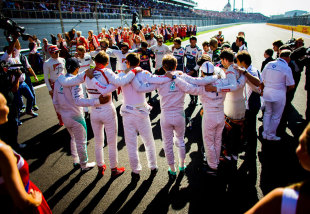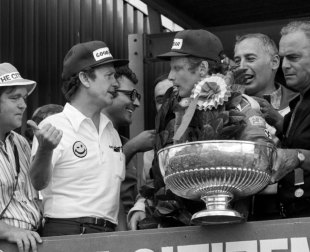

After the events of Suzuka, I was relieved to read a column by Karun Chandhok.
As a professional and articulate racing driver, Karun should know what he's talking about. Referring to the weekend in Sochi, the former F1 driver commented: "I found it really insensitive and actually quite annoying just how many times the drivers and team management were asked by the media whether they were thinking of Jules [Bianchi] and how they were going to focus on their job. They didn't need reminding every few minutes that a member of the F1 family was fighting for his life and there's nothing they can do but pray for him."
As a member of the media, I understand how difficult it is to walk the fine line between portraying the mood and being regarding as insensitive, either by not caring enough or going totally over the top. It's about doing your job while, at the same time, maintaining a balance between explaining the facts and keeping excessive sentiment in check.
This is where experience comes in. I thought Damon Hill and Martin Brundle were brilliant in their analysis of Suzuka on Sky Sports simply because they truly understand what motivates drivers through the thrilling moments and dreadful occasions such as this. They had been there as racing drivers and now they were attempting to apply the same professional standard to the very different and, in my view, infinitely more difficult role of broadcaster. To put it bluntly, they had to ignore the emotion swirling around them and do what they were paid to do without appearing cold and indifferent.
I learned this lesson the hard way. My very first race as a professional journalist was the 1977 South African Grand Prix. This was in the days when there was no television coverage and barely a press office worthy of the name. The only way to cover the race was from the trackside. I chose to stand with photographers and journalists on a grass bank on the outside of Crowthorne, the right-hander at the end of the long main straight where the cars would be in view long enough to make keeping a lap chart reasonably easy.
At the start of lap 23, Tom Pryce crested the rise on the pit straight and hit a 19-year-old fire marshal running across the track to tend to a car (ironically, the Shadow of Pryce's team-mate) that had stopped and caught fire. The heavy extinguisher hit Tom on the head and killed him instantly. The 170-mph impact was so great that the extinguisher flew over the grandstand and damaged a car in the car park.
With Pryce's foot still on the throttle, the Shadow continued at speed, banging along a wall on the right before launching off another car turning into Crowthorne, ploughing through catch-fencing and smashing into the bank beneath us. We had no idea what had led to this terrifying moment. The reason I'm repeating such detail is to explain the personal significance of what came next.
The trauma created by such a violent impact and its visual aftermath can be imagined. In those days - unthinkable now - the race continued, Niki Lauda (unaware of the outcome of Pryce's crash until quietly told on the podium) receiving his trophy and the packing up process beginning, albeit in a subdued manner.
Along with most of the teams, I had a quiet dinner that night in the Kyalami Ranch with Eoin Young, my colleague and mentor. Eoin had been knocked sideways seven years before when his mate, Bruce McLaren, had been killed at Goodwood.

While wrestling with my thoughts, I couldn't help but notice the occasional muted laughter from Emerson Fittipaldi's table nearby. If you're fortunate enough to know Emerson, you will understand that a more compassionate and caring man is difficult to find. I began to realise that this was F1's way of dealing with tragedy and it should not be seen as callous or uncaring. Far from it.
On the flight home, unbeknown to me, Denis Jenkinson arranged to sit beside me. 'Jenks' was the doyen of motor sport writers, the man who sat beside Stirling Moss during that epic 1955 Mille Miglia and a journalist who had seen it all. He asked how I was coping and gently explained that covering accidents such as this was now part of my job. I was no longer an enthusiast. I was being paid to state the facts and my employer would have no interest in personal distress affecting a deadline. If I didn't think I could cope, I should quietly return to the other side of the fence.
I thought about this for the next few days and while attending Pryce's funeral at Otford in Kent. These, as I've said, were different times. My hero Jim Clark had been killed nine years before and tragedy was a frequent and awful consequence of going motor racing. I chose to carry on although, in truth, the decision was never likely to be anything else, such was the lure of this intoxicating sport.
I shudder to think of the uniformed and sensational reaction that would have flooded the Internet and media had Pryce's accident happened today. In 1977, questions were asked and lessons learned. But there was none of the, to quote Chandhok, 'insensitive and annoying' need for a deep and meaningful personal reaction from anyone remotely involved because you, the viewer and reader, allegedly need to know. And none of the hugely damaging culture of lashing out blame without possession of the important details.
As Max Mosley said when President of the FIA: "We're doing everything to reduce the probability of injury on the understanding it can never be zero."
It's a hard fact, but one that some trying to serve our sport need to understand.
Enjoy Maurice's blogs? Vote for him in the UK Blog Awards
Maurice Hamilton writes for ESPN F1.
© ESPN Sports Media Ltd.
 Maurice Hamilton writes for ESPN F1. A veteran journalist in the paddock, Maurice Hamilton has been part of the Formula One scene since 1977 and was the Observer's motor racing correspondent for 20 years. He has written several books as well as commentating on Formula One for BBC Radio 5 Live
Maurice Hamilton writes for ESPN F1. A veteran journalist in the paddock, Maurice Hamilton has been part of the Formula One scene since 1977 and was the Observer's motor racing correspondent for 20 years. He has written several books as well as commentating on Formula One for BBC Radio 5 Live
